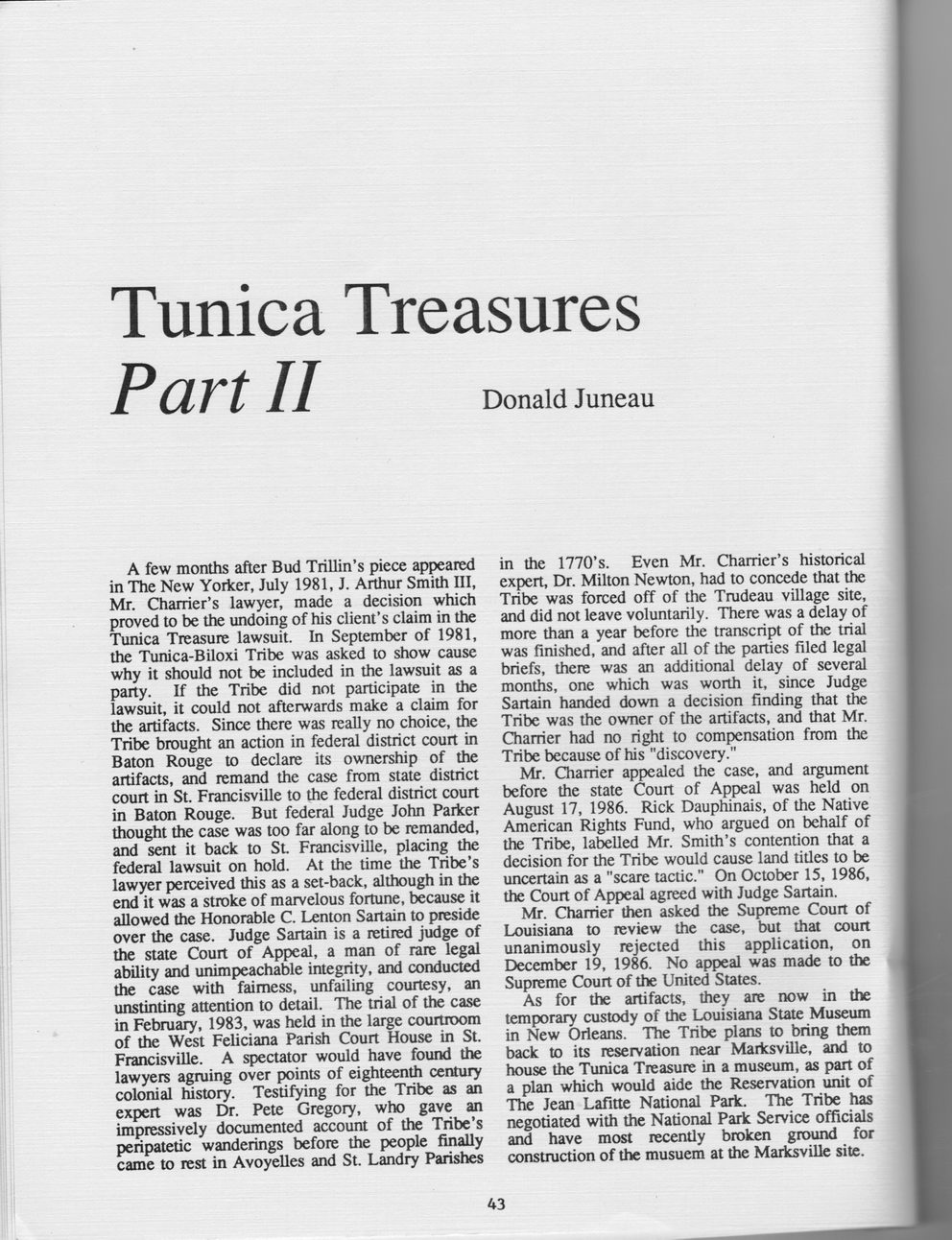This text was obtained via automated optical character recognition.
It has not been edited and may therefore contain several errors.
Tunica Treasures Part II Donald Juneau A few months after Bud Trillin’s piece appeared in The New Yorker, July 1981, J. Arthur Smith III, Mr. Charrier’s lawyer, made a decision which proved to be the undoing of his client’s claim in the Tunica Treasure lawsuit. In September of 1981, the Tunica-Biloxi Tribe was asked to show cause why it should not be included in the lawsuit as a party. If the Tribe did not participate in the lawsuit, it could not afterwards make a claim for the artifacts. Since there was really no choice, the Tribe brought an action in federal district court in Baton Rouge to declare its ownership of the artifacts, and remand the case from state district court in St. Francisville to the federal district court in Baton Rouge. But federal Judge John Parker thought the case was too far along to be remanded, and sent it back to St. Francisville, placing the federal lawsuit on hold. At the time the Tribe’s lawyer perceived this as a set-back, although in the end it was a stroke of marvelous fortune, because it allowed the Honorable C. Lenton Sartain to preside over the case. Judge Sartain is a retired judge of the state Court of Appeal, a man of rare legal ability and unimpeachable integrity, and conducted the case with fairness, unfailing courtesy, an unstinting attention to detail. The trial of the case in February, 1983, was held in the large courtroom of the West Feliciana Parish Court House in St. Francisville. A spectator would have found the lawyers agruing over points of eighteenth century colonial history. Testifying for the Tribe as an expert was Dr. Pete Gregory, who gave an impressively documented account of the Tribe’s peripatetic wanderings before the people finally came to rest in Avoyelles and St. Landry Parishes in the 1770’s. Even Mr. Charrier’s historical expert, Dr. Milton Newton, had to concede that the Tribe was forced off of the Trudeau village site, and did not leave voluntarily. There was a delay of more than a year before the transcript of the trial was finished, and after all of the parties filed legal briefs, there was an additional delay of several months, one which was worth it, since Judge Sartain handed down a decision finding that the Tribe was the owner of the artifacts, and that Mr. Charrier had no right to compensation from the Tribe because of his "discovery." Mr. Charrier appealed the case, and argument before the state Court of Appeal was held on August 17, 1986. Rick Dauphinais, of the Native American Rights Fund, who argued on behalf of the Tribe, labelled Mr. Smith’s contention that a decision for the Tribe would cause land tides to be uncertain as a "scare tactic." On October 15, 1986, the Court of Appeal agreed with Judge Sartain. Mr. Charrier then asked the Supreme Court of Louisiana to review the case, but that court unanimously rejected this application, on December 19, 1986. No appeal was made to the Supreme Court of the United States. As for the artifacts, they are now in the temporary custody of the Louisiana State Museum in New Orleans. The Tribe plans to bring them back to its reservation near Marksville, and to house the Tunica Treasure in a museum, as part of a plan which would aide the Reservation unit of The Jean Lafitte National Park. The Tribe has negotiated with the National Park Service officials and have most recently broken ground for construction of the musuem at the Marksville site. 43

Native Americans The-Tunica-Biloxi-Tribe-its-Culture-and-People-(53)